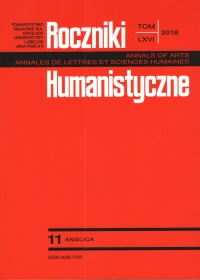From the Profane to the Sacred: Prison-Space Transformations in G.G. Byron’s “The Prisoner of Chillon” and O. Wilde’s “The Ballad of Reading Gaol”
Abstrakt
Od profanum do sacrum. Transformacje przestrzeni więziennej w „Więźniu Czyllonu” G.G. Byrona i „Balladzie o więzieniu w Reading” O. Wilde’a
Artykuł poświęcony jest dwóm utworom o tematyce doświadczenia więziennego: „Więźniowi Czylonu” George’a Gordona Byrona i „Balladzie o więzieniu w Reading” Oskara Wilde’a. Wykorzystując pojęcie „przestrzeni fabuły” (story space) Marie-Laure Ryan, artykuł omawia utwory pod kątem ewolucji postrzegania więzienia, do jakiej dochodzi pod wpływem doświadczeń skazańców. Bohater Byrona, po wielu latach cierpień, zaczyna traktować loch jak swój drugi dom, uświęcony obecnością w nim grobów pochowanych tam braci. U Wilde’a także ma miejsce zmiana percepcji więzienia, będąca wynikiem duchowej przemiany, jaką przechodzą skazańcy. Cela—świat koszmaru, opresji więziennego życia—staje się miejscem modlitwy, umocnienia wiary. W obydwu utworach, można wnioskować, dochodzi do przemiany sfery profanum w sferę sacrum.
Bibliografia
Ahnert, Ruth. 2013. The Rise of Prison Literature in the Sixteenth Century. Cambridge UP.
Bernhard Jackson, Emily A. 2011. “Underground Knowledge: The Prisoner of Chillon and the Genesis of Byronic Knowing.” Romanticism 17 (2): 222–239. http://dx.doi.org/10.1057/9780230290563.
Byron, George Gordon. 2001 (1816). “The Prisoner of Chillon.” Bartleby.com Great Books Online. Accessed 15 February 2018. http://www.bartleby.com/41/479.html.
Cheeke, Stephen. 2003. Byron and Place. History, Translation, Nostalgia. Palgrave Macmillan.
Cochran, Peter. n.d. “Byron and the Essence of Imprisonment.” Newstead Abbey Byron Society. Accessed 20 April 2018. http://www.newsteadabbeybyronsociety.org/works/downloads/essence.pdf.
Cochran, Peter. 1997. “Lord Byron: The Prisoner of Chillon. Textual Introduction. The Prisoner of Chillon: The Case for Multiple Authorship. Albè, Percy, Mary, Clare.” Newstead Abbey Byron Society. Accessed 20 April 2018. http://www.newsteadabbeybyronsociety.org/works/downloads/prisoner_of_chillon.pdf.
De Marinis Mezzapesa, Dalila. 2013. “Murder Ballads: Crime and Society in Victorian Literature.” Journal of Artistic Creation and Literary Research 1 (1): 45-56. Universidad Complutense de Madrid, Spain. Accessed 10 April 2018. https://www.ucm.es/data/cont/docs/119-2013-08-22-1.1.4.DeMarinis.pdf.
Freeman, Thomas S. 2009. “Introduction. The Rise of Prison Literature.” Huntington Library Quarterly, 72 (2): 133-146. http://dx.doi.org/10.1525/hlq.2009.72.2.133.
Harrison, Brandy Laurel Helen. 2015, These Bloody Days: Prison, Treason, and the Birth of Literary Witness in the Poetry of Sir Thomas Wyatt. MA Thesis. Kingston, Ontario, Canada.
Lodge, David. 2015. The Modes of Modern Writing: Metaphor, Metonymy, and the Typology of Modern Literature. London, New Delhi, New York, Sydney: Bloomsbury.
Marcovitch, Heather. 2010. The Art of the Pose: Oscar Wilde’s Performance Theory. Peter Lang.
Mullan, John. 2009, “Ten of the Best Books Written in Prison.” The Guardian. International Edition. Accessed 25 February 2018. https://www.theguardian.com/books/2009/sep/19/books-written-in-prison.
Nassar, Christopher S. 1995. “Wilde’s The Ballad of Reading Gaol.” The Explicator 53: 158-161.
Nelson, Max. “In the Madhouse.” The Paris Review, 5 January 2016. The Paris Review. Blog. Accessed 20 April 2018. https://www.theparisreview.org/blog/2016/01/05/in-the-madhouse/.
O’Brien, Ellen L. 2001. “‘Every Man Who Is Hanged Leaves a Poem’: Criminal Poets in Victorian Street Ballads.” Victorian Poetry, 39 (2): 319-339.
Powell, Lucy. 2018. “Doing Time: Temporality and Writing in the Eighteenth-Century British Prison Experience.” Life Writing 15 (1): 59-77. http://dx.doi.org/10.1080/14484528.2015.1118665.
Robinson, Peter. 2015. “Sex, Lies, and Poetry: The Ballad of Reading Gaol.” The Cambridge Quarterly 44 (4): 299–320. https://doi.org/10.1093/camqtly/bfv024.
Rotstein, Robert. 2013. “Twelve Famous Writers Who Did Time.” 6.07.2013. The Blog. Huffpost. Accessed 15 February 2018. https://www.huffingtonpost.com/robert-rotstein/famous-authors-who-did-ti_b_3403276.html.
Ryan, Marie-Laure. 2009. “Space.” In Peter Hühn, John Pier, Wolf Schmid, and Jörg Schönert (eds). Handbook of Narratology, 420-434. Berlin: Walter de Gruyter.
Sawicki, Stefan. 1980. “Sacrum w literaturze.” Roczniki humanistyczne, 28 (1): 13–26.
Sitter, Zahary. 2006. “Christopher Smart.” In David Scott Kastan (ed.). The Oxford Encyclopedia of British Literature, 24–28. Oxford UP.
Wilde, Oscar. 2003 (1897). The Ballad of Reading Gaol. University of Toronto libraries. RPO – Representative Poetry Online. Accessed 10 February 2018. https://rpo.library.utoronto.ca/poems/ballad-reading-gaol.
Willoughby, Guy. 1987. The Figure of Christ in the Works of Oscar Wilde. PhD Thesis. University of Cape Town.
Copyright (c) 2018 Roczniki Humanistyczne

Utwór dostępny jest na licencji Creative Commons Uznanie autorstwa – Użycie niekomercyjne – Bez utworów zależnych 4.0 Międzynarodowe.





